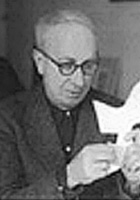Jean Arp
Jean Arp Poems
(Translated from the French by David Gascoyne)
The feet of morning the feet of noon and the feet of evening
walk ceaselessly round pickled buttocks
...
I was alone with a chair on a plain
Which lost itself in an empty horizon.
The plain was flawlessly paved.
...
The air is a root.
The stones are filled with tenderness. bravo.
bravo. the stones are filled with air.
the stones are watery branches.
...
(Translated by G P Skratz)
o god our kaspar is dead
& now there's no-one to steal away with the burning flag &
...
1.
weh unser guter kaspar ist tot
wer trägt nun die brennende fahne im zopf wer dreht die
...
1
die rosen werden an die hüte gekreuzigt, die lippen
der rosen fliegen fort.
...
Jean Arp Biography
Jean Arp / Hans Arp was a German-French, or Alsatian, sculptor, painter, poet and abstract artist in other media such as torn and pasted paper. When Arp spoke in German he referred to himself as "Hans", and when he spoke in French he referred to himself as "Jean". Many people believe that he was born Hans and later changed his name to Jean, but this is not the case. Early Life Arp was born in Strasbourg. The son of a French mother and a German father, he was born during the period following the Franco-Prussian War when the area was known as Alsace-Lorraine (Elsass-Lothringen in German) after it had been returned to Germany by France. Following the return of Alsace to France at the end of World War I, French law determined that his name become Jean. In 1904, after leaving the École des Arts et Métiers in Strasbourg, he went to Paris where he published his poetry for the first time. From 1905 to 1907, Arp studied at the Kunstschule, Weimar, Germany and in 1908 went back to Paris, where he attended the Académie Julian. In 1915, he moved to Switzerland, to take advantage of Swiss neutrality. Arp later told the story of how, when he was notified to report to the German consulate, he avoided being drafted into the army: he took the paperwork he had been given and, in the first blank, wrote the date. He then wrote the date in every other space as well, then drew a line beneath them and carefully added them up. He then took off all his clothes and went to hand in his paperwork. He was told to go home. Career Arp was a founding member of the Dada movement in Zürich in 1916. In 1920, as Hans Arp, along with Max Ernst, and the social activist Alfred Grünwald, he set up the Cologne Dada group. However, in 1925 his work also appeared in the first exhibition of the surrealist group at the Galérie Pierre in Paris. In 1926, Arp moved to the Paris suburb of Meudon. In 1931, he broke with the Surrealist movement to found Abstraction-Création, working with the Paris-based group Abstraction-Création and the periodical, Transition. Throughout the 1930s and until the end of his life, he wrote and published essays and poetry. In 1942, he fled from his home in Meudon to escape German occupation and lived in Zürich until the war ended. Arp visited New York City in 1949 for a solo exhibition at the Buchholz Gallery. In 1950, he was invited to execute a relief for the Harvard University Graduate Center in Cambridge, Massachusetts would also be commissioned to do a mural at the UNESCO building in Paris. In 1954, Arp won the Grand Prize for Sculpture at the Venice Biennale. In 1958, a retrospective of his work was held at the Museum of Modern Art in New York City, followed by an exhibition at the Musée National d'Art Moderne, Paris, France, in 1962. The Musée d'art moderne et contemporain of Strasbourg houses many of his paintings and sculptures. Personal life and death Arp's first wife, the artist Sophie Taeuber-Arp, died in Zürich in 1943, and he subsequently married the collector Marguerite Hagenbach. Arp died in 1966, in Basel, Switzerland.)
The Best Poem Of Jean Arp
The Domestic Stones (Fragment)
(Translated from the French by David Gascoyne)
The feet of morning the feet of noon and the feet of evening
walk ceaselessly round pickled buttocks
on the other hand the feet of midnight remain motionless
in their echo-woven baskets
consequently the lion is a diamond
on the sofas made of bread
are seated the dressed and the undressed
the undressed hold leaden swallows between their toes
the dressed hold leaden nests between their fingers
at all hours the undressed get dressed again
and the dressed get undressed
and exchange the leaden swallows for the leaden nests
consequently the tail is an umbrella
a mouth opens within another mouth
and within this mouth another mouth
and within this mouth another mouth
and so on without end
it is a sad perspective
which adds an I-don't-know-what
to another I-don't-know-what
consequently the grasshopper is a column
the pianos with heads and tails
place pianos with heads and tails
on their heads and their tails
consequently the tongue is a chair
